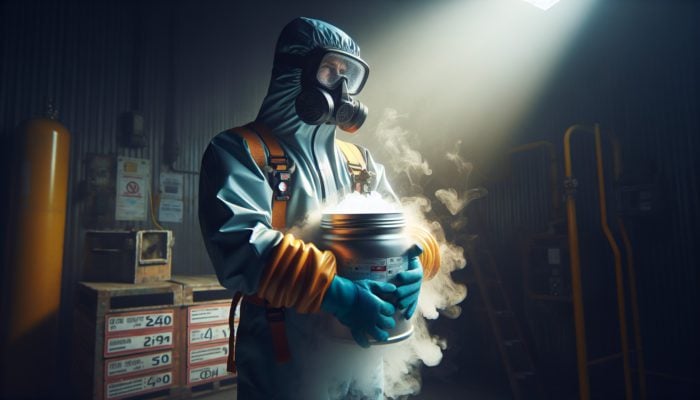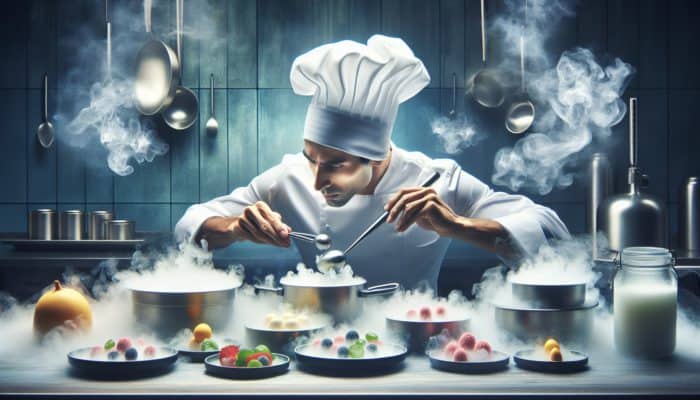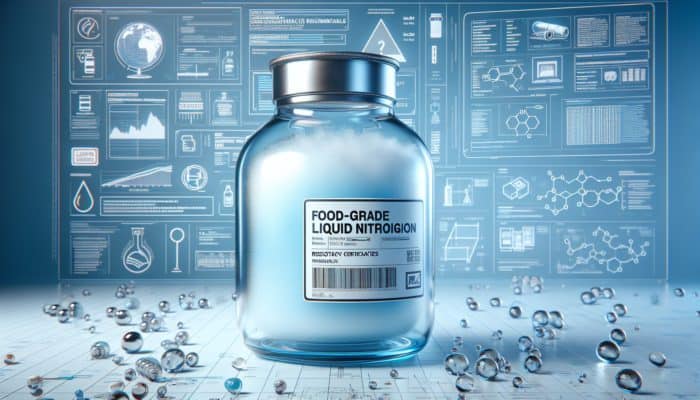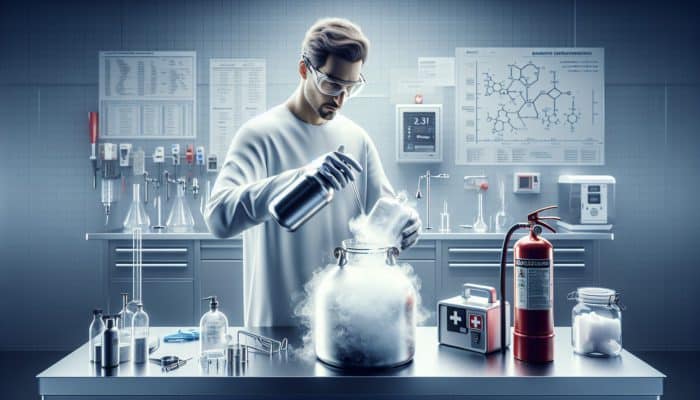Prioritising Safety When Handling Liquid Nitrogen
Essential Protective Gear for Safe Handling

When working with liquid nitrogen, prioritising safety is crucial. This clear, colourless cryogenic liquid can cause severe injuries if not managed with caution. Always ensure you wear suitable protective gear, which should include insulated gloves specifically designed for cryogenic substances, goggles to protect your eyes, and a face shield to guard against potential splashes. The extreme cold of liquid nitrogen can induce frostbite almost instantaneously, making it vital to cover any exposed skin. Additionally, opt for clothing that fully covers your arms and legs to minimise the risk of accidental contact with this hazardous material.
In environments such as professional kitchens or any areas where liquid nitrogen is utilised, establishing a robust safety culture is essential. Every team member should be educated about the risks associated with liquid nitrogen. Implement regular safety training sessions that stress the importance of wearing protective gear and adhering to established safety protocols. By cultivating a safety-first mindset, the likelihood of accidents diminishes significantly, creating a safer atmosphere for everyone involved.
Ensuring Proper Ventilation When Using Liquid Nitrogen
The vapour from liquid nitrogen can displace oxygen in the air, which poses a risk of asphyxiation. Therefore, it is imperative to maintain adequate ventilation in any area where liquid nitrogen is being used. Working in a well-ventilated room or outdoors is advisable to allow excess nitrogen gas to dissipate freely. Installing exhaust fans can significantly enhance air circulation, helping to ensure that nitrogen vapour does not accumulate to hazardous levels.
It is also essential to continuously monitor oxygen levels in the workspace, especially in enclosed areas. Employing oxygen sensors can provide real-time data, alerting you to potential dangers. If the sensor indicates low oxygen levels, vacate the area immediately. Prioritising proper ventilation not only promotes safety but also enhances comfort in the working environment, facilitating culinary creativity when working with liquid nitrogen.
Establishing Emergency Procedures for Liquid Nitrogen Incidents
Having a well-defined emergency procedure in place is imperative when working with liquid nitrogen. Prepare a detailed plan that includes the location of the nearest first aid kit and emergency contact numbers. It is vital that all personnel are familiar with these procedures and understand how to respond in the event of an accident. Regular drills should be conducted to keep everyone alert and prepared for any emergency situation that may arise.
In case of a spill, evacuating the area is crucial, allowing the liquid nitrogen to evaporate completely before commencing any clean-up activities. Quick access to professional medical assistance can significantly impact the treatment of frostbite or other injuries resulting from liquid nitrogen exposure. Being thoroughly prepared can greatly reduce the risks associated with using this powerful culinary tool.
Expert Recommendations for Mastering Cooking with Liquid Nitrogen

Culinary Techniques Used by Top Chefs
Renowned chefs globally have embraced liquid nitrogen as an innovative tool in their culinary repertoire, leveraging its unique properties to craft extraordinary dishes. While techniques vary widely, several key methods are commonly employed to achieve stunning culinary results. Here are some popular techniques utilised by culinary experts:
- Flash Freezing: Allows for the instant freezing of ingredients, resulting in unique textures.
- Instant Ice Cream: Produces smooth, creamy ice cream by rapidly freezing the mixture.
- Spherification: Forms spheres of flavoured liquids through rapid freezing methods.
- Textural Contrast: Enhances dishes by introducing crispy elements that contrast with softer components.
- Smoke Effects: Creates dramatic visual presentations that elevate the dining experience.
- Infusion: Enables the rapid infusion of flavours into various ingredients.
- Garnishing: Adds visually appealing frozen garnishes to enhance dishes.
- Molecular Gastronomy: Explores innovative techniques that push the boundaries of traditional cooking.
For instance, chef Heston Blumenthal is celebrated for his innovative use of liquid nitrogen to create unique textural contrasts in his dishes, while chefs such as Ferran Adrià have pioneered its use in molecular gastronomy to craft exhilarating dining experiences that delight the palate.
What Distinguishes Liquid Nitrogen from Other Cooking Ingredients?
The remarkable uniqueness of liquid nitrogen lies in its extraordinary properties, particularly its extremely low temperature of -196°C (-321°F). This incredible cold enables the instantaneous freezing of foods, resulting in surprising culinary effects. The rapid freezing process preserves the integrity, flavour, and nutritional value of ingredients, creating textures and tastes that are unattainable through conventional methods.
Moreover, the ability to achieve flash freezing opens up exciting avenues for culinary creativity. Ingredients can be combined in ways that would typically yield undesirable outcomes if subjected to slower freezing techniques. For example, fruits can be frozen rapidly to maintain their cellular structure, which leads to vibrant colours and crisp textures. Understanding the unique properties of liquid nitrogen empowers chefs to experiment boldly, resulting in innovative dishes that captivate and delight diners.
How Can You Source High-Quality Liquid Nitrogen?

Acquiring high-quality liquid nitrogen for culinary purposes involves identifying reputable suppliers. Industrial gas suppliers typically provide food-grade liquid nitrogen that is suitable for cooking applications. It is essential to ensure that the nitrogen sourced is certified for food use, as this guarantees safety and quality for culinary applications.
Conduct thorough research on local suppliers and review customer feedback to assess their reliability. Many suppliers offer convenient delivery services, ensuring timely access to liquid nitrogen. Always check the storage conditions and handling protocols they follow to guarantee that the nitrogen remains safe for culinary use. When engaging with suppliers, discussing your specific needs—such as quantity and frequency of supply—can help streamline your purchasing process and ensure consistent availability.
How Does Liquid Nitrogen Transform Food Texture?
Creating Crunchy and Appealing Textures
Utilising liquid nitrogen can be a game changer when it comes to achieving crunchy textures in various foods. The flash-freezing process allows chefs to create a crispy exterior while keeping the interior soft and moist. This technique is particularly beneficial for items like fruits or specific pastries that thrive on contrasting textures.
For instance, dipping fruit, such as berries, into liquid nitrogen results in an immediate crispness that enhances their natural sweetness. The rapid freezing prevents the formation of large ice crystals, which can lead to mushiness if frozen using traditional methods. Instead, the fruit maintains its form and vibrant colour, yielding an appealing crunchy snack or garnish. This method can also be applied to dessert components, such as meringues or sponge cakes, facilitating creative presentations that play with texture and visual appeal.
Enhancing Creaminess and Texture in Culinary Creations
Liquid nitrogen can significantly enhance the creaminess of various culinary creations, especially ice creams and sauces. By rapidly freezing mixtures, the size of ice crystals is minimised, leading to a smoother, creamier texture. This is particularly advantageous for custards or cream-based sauces that would typically require extended chilling periods to achieve the desired consistency.
When crafting ice cream with liquid nitrogen, the process is not only quick but also allows for the incorporation of unique flavours and ingredients just before freezing. For instance, blending in fruits, chocolate, or even herbs can produce a final product that is rich in flavour and texture. The rapid freezing ensures these ingredients remain evenly distributed throughout the ice cream, enhancing the overall culinary experience.
Achieving Unique and Innovative Food Combinations
The rapid freezing capabilities of liquid nitrogen enable the creative combination of ingredients that might not typically blend well together. This technique allows chefs to explore flavour pairings and ingredients that would ordinarily clash or separate during conventional cooking processes. By instantly freezing components, chefs can maintain a high level of experimentation in their culinary creations.
For example, flavours from different cuisines can be combined without compromising their individual characteristics. A chef might freeze herbal infusions and blend them with creamy bases, resulting in unique sauces that surprise diners with each bite. The flexibility offered by liquid nitrogen creates opportunities for innovative pairings, leading to dishes that challenge traditional culinary norms and excite the palate with unexpected flavours and textures.
Exciting Recipes Featuring Liquid Nitrogen
Innovative Desserts and Confections
Liquid nitrogen holds a significant place in the dessert realm, enabling the creation of extraordinary sweet treats that entice the senses. The flash-freezing ability provides a fresh dimension to traditional desserts, resulting in unique textures and flavours. Here are some popular dessert recipes that effectively utilise liquid nitrogen:
- Liquid Nitrogen Ice Cream: Create instant ice cream with your choice of flavours by combining cream, sugar, and desired flavourings, then flash freezing with liquid nitrogen.
- Frozen Fruit Sorbet: Blend fresh fruit with sugar and lemon juice, then freeze immediately for a refreshing sorbet.
- Molecular Chocolate Mousse: Whip chocolate with cream and quickly freeze using nitrogen for a light, airy texture.
- Frozen Cheesecake Bites: Dip cheesecake pieces in nitrogen to develop a crunchy exterior while keeping a creamy inside.
- Ice Cream Bombs: Enclose ice cream inside a shell made of chocolate and freeze instantly for a delightful surprise.
These recipes not only highlight the versatility of liquid nitrogen but also underscore the creativity it inspires in dessert preparation. Each dish offers an opportunity to experiment with flavours, textures, and presentations, making them a hit in both home kitchens and professional culinary settings.
Exciting Savoury Dishes Using Liquid Nitrogen
While desserts may be the most common application of liquid nitrogen, it has also carved a niche in savoury dishes. The dramatic effect of flash freezing allows chefs to create visually stunning components that elevate any meal. For instance, flash-frozen garnishes can be added to soups and salads, providing a surprising crunch and an artistic touch.
With the help of liquid nitrogen, chefs can also prepare unique presentations of traditional dishes. Imagine a classic soup served with a swirling mist of nitrogen vapour or a salad featuring frozen herbs that crackle upon biting. These techniques not only enhance flavour profiles but also create memorable dining experiences that leave guests in awe. The versatility of liquid nitrogen in savoury cooking paves the way for innovative culinary exploration.
Innovative Beverages and Cocktails with Liquid Nitrogen
The creative use of liquid nitrogen in beverages and cocktails has opened a new frontier in mixology. Bartenders across the globe have embraced this technique to craft innovative drinks that not only taste exceptional but also provide a striking visual experience. Liquid nitrogen can be employed to chill drinks instantly or to create unique textures, resulting in an exhilarating cocktail experience.
For example, cocktails can be prepared with frozen fruit juices or infused spirits that have been quickly frozen and crushed. This results in a refreshing and visually appealing drink with an unexpected twist. Moreover, the dramatic effect of smoke and fog created by liquid nitrogen adds an exciting layer to cocktail presentations. Guests can enjoy a cocktail that tantalises their taste buds while engaging their senses through a captivating visual spectacle.
Research-Backed Insights on the Benefits of Cooking with Liquid Nitrogen
Preserving Nutritional Value Through Rapid Freezing
One of the most significant advantages of using liquid nitrogen in cooking is its ability to preserve the nutritional value of ingredients. The rapid freezing process locks in nutrients, preventing degradation that often occurs during traditional cooking methods. For example, fruits and vegetables can be frozen immediately after harvest, maintaining their vitamin content and overall freshness.
This method is particularly beneficial for creating healthy meals and snacks. By utilising liquid nitrogen, chefs can preserve the integrity of ingredients, ensuring that dishes are not only delicious but also nutritious. Furthermore, maintaining the colour and texture of fruits and vegetables enhances dish appeal, encouraging healthier eating habits among diners who appreciate visually appealing meals.
Food Safety Considerations When Using Liquid Nitrogen
Food safety is another critical aspect of utilising liquid nitrogen in culinary applications. The instant freezing process helps eliminate pathogens by rapidly lowering the temperature of foods, thus preventing bacterial growth. This is especially important for ingredients that may be susceptible to spoilage, such as seafood or dairy products.
By incorporating liquid nitrogen into the cooking process, chefs can ensure that their dishes are not only safe to consume but also retain high-quality flavours. However, it is essential to adhere to strict hygiene practices when handling nitrogen and food ingredients to maximise safety benefits and ensure the well-being of diners.
Scientifically Proven Techniques Enhancing Culinary Outcomes
Numerous studies have highlighted the advantages of utilising liquid nitrogen in cooking, particularly regarding texture and flavour enhancement. The precise control over temperature allows chefs to experiment with various techniques, yielding scientifically backed results. For instance, research has demonstrated that flash freezing preserves cellular structure, resulting in improved mouthfeel and overall enjoyment of food.
Understanding the scientific principles behind each technique enables chefs to refine their craft further. By leveraging techniques that have been proven effective, culinary professionals can create dishes that consistently impress diners, leading to greater success in the culinary industry and enhancing their reputations.
Fostering Culinary Creativity with Liquid Nitrogen
The use of liquid nitrogen unlocks a realm of possibilities for culinary creativity, allowing chefs to experiment with flavours, textures, and presentations that were previously unattainable. This innovative approach to cooking paves the way for the emergence of new culinary trends and styles, transforming the dining experience for patrons.
Chefs can utilise liquid nitrogen to create visually stunning dishes that engage the senses and challenge conventional cooking norms. For instance, the ability to create dramatic presentations or unexpected flavour combinations can leave diners with lasting impressions. As culinary innovation continues to evolve, the role of liquid nitrogen will undoubtedly be significant in shaping the future of gastronomy.
What Risks Should You Be Aware of When Using Liquid Nitrogen in Cooking?
Identifying Potential Health Hazards
While liquid nitrogen offers remarkable opportunities in the kitchen, it also presents potential health risks that must be addressed with seriousness. Improper handling can lead to severe injuries, including frostbite from direct skin contact or inhalation of nitrogen vapour, which can cause asphyxiation. It is vital to understand these risks and implement appropriate safety measures to mitigate them effectively.
All individuals working with nitrogen must receive training in safe handling practices. This training includes being aware of the signs of frostbite and asphyxiation, as well as understanding how to react during emergencies. Following strict safety protocols can significantly reduce the risk of accidents, ensuring a safer cooking environment for everyone involved.
Addressing Equipment and Storage Concerns
Handling and storing liquid nitrogen necessitate specialised equipment to prevent accidents and maintain its effectiveness. Liquid nitrogen should be stored in vacuum-insulated containers specifically designed for cryogenic materials. These containers are engineered to prevent pressure build-up and ensure safe storage, safeguarding against potential hazards.
Improper storage can lead to dangerous situations, such as pressure explosions or spills. Regular inspections of equipment for leaks or damage are essential to maintain a safe working environment. Additionally, training personnel on proper storage techniques contributes to overall safety and efficiency in the kitchen, ensuring that everyone can work safely with this powerful ingredient.
Understanding Legal and Regulatory Issues Surrounding Liquid Nitrogen Use
When using liquid nitrogen in food preparation, it is crucial to remain aware of the legal and regulatory considerations that may apply. Some regions have specific regulations regarding the use of liquid nitrogen in culinary settings, particularly concerning safety practices and food handling procedures. Ensuring compliance with local laws is essential to avoid potential legal repercussions.
Staying informed about any changes in regulations regarding liquid nitrogen usage ensures that culinary establishments maintain compliance. This not only helps safeguard staff and customers but also reinforces the establishment’s reputation for prioritising safety and quality in food preparation.
Practical Handling Tips for Liquid Nitrogen
Measuring and Pouring Liquid Nitrogen Safely
Effectively measuring and pouring liquid nitrogen is vital for safe and precise culinary applications. Always use insulated containers designed for cryogenic liquids to prevent spills and splashes that can cause injuries. Pouring slowly and carefully is essential, as this reduces the risk of splashing and allows for better control over the amount being used to achieve desired results.
Additionally, practice good housekeeping when working with liquid nitrogen. Ensure that your workspace is free of clutter and that all necessary tools are within reach. Organising the area before use can greatly enhance efficiency and safety when handling this volatile substance, allowing for a smoother workflow in the kitchen.
Effective Temperature Management Techniques
Maintaining proper temperature management while working with liquid nitrogen is essential for achieving the desired culinary outcomes. Keep the cooking area well-ventilated to ensure that any nitrogen vapour dissipates quickly, promoting safety and preventing any disruption to the cooking process.
Using insulated gloves is crucial when handling any items that have been in contact with liquid nitrogen. These gloves protect against frostbite and provide a secure grip on containers and tools. Applying proper temperature management techniques ensures a safe and effective cooking environment, enabling chefs to focus on their culinary creations.
Safe Clean-Up and Disposal Procedures for Liquid Nitrogen
Implementing proper clean-up and disposal methods for liquid nitrogen is vital to maintaining a safe working environment. Allow any spilled liquid nitrogen to evaporate completely before attempting to clean the area. Never try to wipe up liquid nitrogen with cloths or absorbent materials, as this can lead to further hazards and potential accidents.
When disposing of empty containers that previously held liquid nitrogen, follow local regulations for hazardous waste disposal. Ensure that containers are completely empty and allow them to return to ambient temperatures before disposal. Taking these precautions will contribute to a safer kitchen environment, preventing accidental exposure to nitrogen and ensuring compliance with safety standards.
- Allow any spilled liquid nitrogen to evaporate completely.
- Clean surfaces with warm water after evaporation.
- Dispose of empty containers according to local regulations.
- Ensure no residual nitrogen remains in containers before disposal.
- Regularly inspect all equipment for leaks or damage.
Creative Presentation Ideas Using Liquid Nitrogen
Employing Dramatic Serving Techniques
The visual appeal of dishes can be dramatically enhanced through creative serving techniques involving liquid nitrogen. The instantaneous freezing effect creates enchanting smoke and fog, adding an exciting element to the dining experience. For instance, serving desserts or cocktails surrounded by a swirling mist of nitrogen vapour not only captivates guests but also heightens their anticipation of the culinary delights to come.
Consider using liquid nitrogen to create dramatic effects during the serving process. For example, when presenting a dish, a chef can release liquid nitrogen to envelop the plate in a mist, creating an unforgettable visual moment that enhances the overall dining experience. This theatrical flair not only entertains diners but also makes their experience memorable and engaging.
Designing Themed Dining Experiences
Liquid nitrogen can play a pivotal role in enhancing themed dining experiences. Chefs can design dishes specifically tailored to fit certain themes, employing liquid nitrogen techniques to elevate the atmosphere and create a cohesive dining experience. For instance, a “futuristic” dining concept could incorporate elements like frozen cocktails or desserts that create stunning visual spectacles, adding excitement and intrigue.
By aligning dishes with the theme and utilising liquid nitrogen, chefs can create cohesive dining experiences that resonate with guests. The integration of innovative cooking techniques into themed menus not only adds excitement but also elevates the overall dining concept, making it appealing to a wide range of patrons seeking unique culinary adventures.
Implementing Interactive Dining Concepts
Interactive dining experiences are gaining popularity, and liquid nitrogen can enhance this trend by allowing guests to participate in the cooking process. Imagine a dining setting where diners can utilise liquid nitrogen to create their own frozen treats at the table, adding an element of fun and engagement to the meal that encourages conversation and interaction.
Incorporating guest interaction elevates the dining experience, fostering a sense of connection between diners and the culinary arts. Providing a controlled environment with proper safety measures ensures that guests can safely enjoy the process of creating their own culinary creations. This hands-on approach transforms each meal into an unforgettable occasion, making it a memorable experience for diners.
Exploring Molecular Gastronomy Experiments
Utilising liquid nitrogen for molecular gastronomy experiments presents an exciting opportunity for chefs to explore innovative culinary techniques. Flash freezing allows for the creation of unique textures and flavours that challenge traditional cooking methods. Chefs can experiment with ingredients and flavour combinations, using liquid nitrogen to push the boundaries of culinary creativity.
For instance, chefs may create frozen foams or spheres that burst with flavour when bitten into, surprising diners with an explosion of taste. These experiments not only showcase the versatility of liquid nitrogen but also highlight the innovative spirit of modern gastronomy. As chefs continue to explore molecular gastronomy, liquid nitrogen will remain an essential tool in their culinary toolkit, enabling them to create extraordinary dishes that captivate and delight.
Educational Demonstrations Involving Liquid Nitrogen
Incorporating liquid nitrogen into educational settings provides a unique opportunity to demonstrate its properties and safe usage. Cooking classes or science demonstrations that utilise nitrogen can engage students and foster a deeper understanding of both culinary arts and scientific principles. By showcasing the dramatic effects of liquid nitrogen, educators can create memorable learning experiences that inspire future generations of chefs and scientists.
Demonstrations can include various applications of liquid nitrogen, such as creating frozen desserts, showcasing the principles of thermal expansion, or discussing the safety measures necessary when working with cryogenic materials. This multifaceted approach to education not only enhances learning but also inspires curiosity and innovation among students, encouraging them to explore the possibilities within their fields.
Frequently Asked Questions About Liquid Nitrogen
What is liquid nitrogen and its culinary uses?
Liquid nitrogen is nitrogen in a liquid state at an extremely low temperature, used in cooking for its rapid freezing properties that enhance texture and flavour.
Is liquid nitrogen safe to use in cooking?
When handled properly with appropriate safety measures, liquid nitrogen is safe for culinary applications; however, mishandling can lead to serious injuries, making safety training essential.
What types of dishes can be created using liquid nitrogen?
Liquid nitrogen can be used to create a variety of dishes, including ice creams, sorbets, frozen garnishes, and innovative cocktails that enhance the overall dining experience.
How does liquid nitrogen impact food texture?
Liquid nitrogen flash-freezes foods, resulting in unique textures, such as crunchy exteriors while keeping the interiors soft and moist, enhancing the overall dining experience.
Can I purchase liquid nitrogen for home use?
Yes, liquid nitrogen can be obtained from industrial gas suppliers; however, it must be handled with care and stored in appropriate containers to ensure safety.
What protective gear is necessary when using liquid nitrogen?
When using liquid nitrogen, it is crucial to wear insulated gloves, goggles, and a face shield to protect against potential frostbite and injuries from accidental exposure.
What are the risks associated with using liquid nitrogen?
Potential risks include frostbite, asphyxiation from nitrogen gas, and accidents during handling if proper safety protocols are not followed, highlighting the importance of safety training.
How does liquid nitrogen help preserve food nutrition?
Flash-freezing with liquid nitrogen locks in nutrients and flavour, preventing degradation that can occur with traditional cooking methods, contributing to healthier meals.
Are there any legal regulations concerning the use of liquid nitrogen in food preparation?
Yes, some regions have specific regulations regarding the culinary use of liquid nitrogen, focusing on safety practices and food handling that must be adhered to by culinary establishments.
What cleanup procedures should be followed after using liquid nitrogen?
After using liquid nitrogen, allow any spilled nitrogen to evaporate completely, and dispose of empty containers according to local regulations to ensure safety and prevent exposure.

